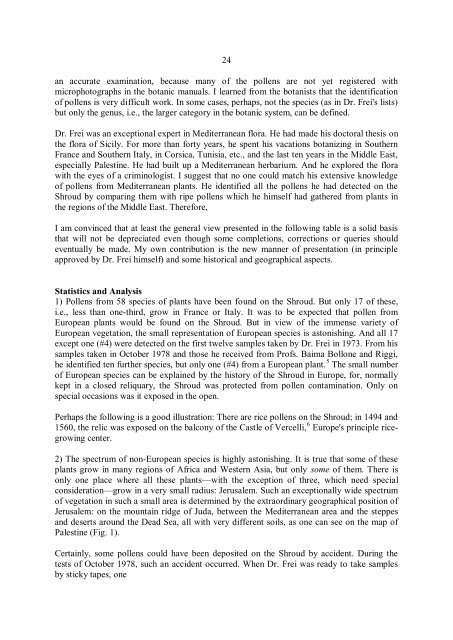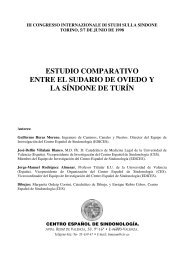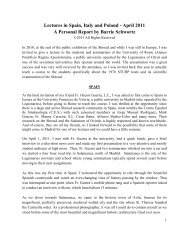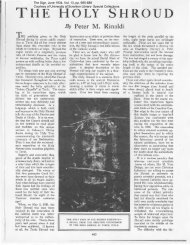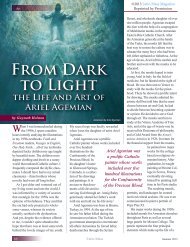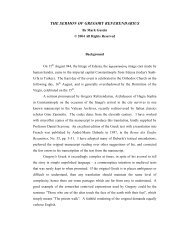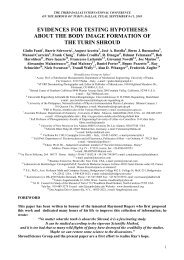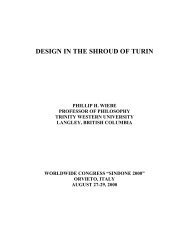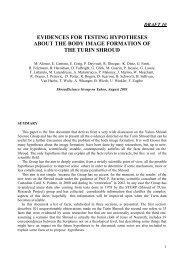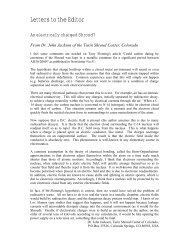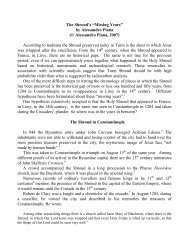Create successful ePaper yourself
Turn your PDF publications into a flip-book with our unique Google optimized e-Paper software.
24an accurate examinati<strong>on</strong>, because many <strong>of</strong> <strong>the</strong> pollens are not yet registered withmicrophotographs in <strong>the</strong> botanic manuals. I learned from <strong>the</strong> botanists that <strong>the</strong> identificati<strong>on</strong><strong>of</strong> pollens is very difficult work. In some cases, perhaps, not <strong>the</strong> species (as in Dr. Frei's lists)but <strong>on</strong>ly <strong>the</strong> genus, i.e., <strong>the</strong> larger category in <strong>the</strong> botanic system, can be defined.Dr. Frei was an excepti<strong>on</strong>al expert in Mediterranean flora. He had made his doctoral <strong>the</strong>sis <strong>on</strong><strong>the</strong> flora <strong>of</strong> Sicily. For more than forty years, he spent his vacati<strong>on</strong>s botanizing in Sou<strong>the</strong>rnFrance and Sou<strong>the</strong>rn Italy, in Corsica, Tunisia, etc., and <strong>the</strong> last ten years in <strong>the</strong> Middle East,especially Palestine. He had built up a Mediterranean herbarium. And he explored <strong>the</strong> florawith <strong>the</strong> eyes <strong>of</strong> a criminologist. I suggest that no <strong>on</strong>e could match his extensive knowledge<strong>of</strong> pollens from Mediterranean plants. He identified all <strong>the</strong> pollens he had detected <strong>on</strong> <strong>the</strong><strong>Shroud</strong> by comparing <strong>the</strong>m with ripe pollens which he himself had ga<strong>the</strong>red from plants in<strong>the</strong> regi<strong>on</strong>s <strong>of</strong> <strong>the</strong> Middle East. <str<strong>on</strong>g>The</str<strong>on</strong>g>refore,I am c<strong>on</strong>vinced that at least <strong>the</strong> general view presented in <strong>the</strong> following table is a solid basisthat will not be depreciated even though some completi<strong>on</strong>s, correcti<strong>on</strong>s or queries shouldeventually be made. My own c<strong>on</strong>tributi<strong>on</strong> is <strong>the</strong> new manner <strong>of</strong> presentati<strong>on</strong> (in principleapproved by Dr. Frei himself) and some historical and geographical aspects.Statistics and Analysis1) <str<strong>on</strong>g>Pollen</str<strong>on</strong>g>s from 58 species <strong>of</strong> plants have been found <strong>on</strong> <strong>the</strong> <strong>Shroud</strong>. But <strong>on</strong>ly 17 <strong>of</strong> <strong>the</strong>se,i.e., less than <strong>on</strong>e-third, grow in France or Italy. It was to be expected that pollen fromEuropean plants would be found <strong>on</strong> <strong>the</strong> <strong>Shroud</strong>. But in view <strong>of</strong> <strong>the</strong> immense variety <strong>of</strong>European vegetati<strong>on</strong>, <strong>the</strong> small representati<strong>on</strong> <strong>of</strong> European species is ast<strong>on</strong>ishing. And all 17except <strong>on</strong>e (#4) were detected <strong>on</strong> <strong>the</strong> first twelve samples taken by Dr. Frei in 1973. From hissamples taken in October 1978 and those he received from Pr<strong>of</strong>s. Baima Boll<strong>on</strong>e and Riggi,he identified ten fur<strong>the</strong>r species, but <strong>on</strong>ly <strong>on</strong>e (#4) from a European plant. 5 <str<strong>on</strong>g>The</str<strong>on</strong>g> small number<strong>of</strong> European species can be explained by <strong>the</strong> history <strong>of</strong> <strong>the</strong> <strong>Shroud</strong> in Europe, for, normallykept in a closed reliquary, <strong>the</strong> <strong>Shroud</strong> was protected from pollen c<strong>on</strong>taminati<strong>on</strong>. Only <strong>on</strong>special occasi<strong>on</strong>s was it exposed in <strong>the</strong> open.Perhaps <strong>the</strong> following is a good illustrati<strong>on</strong>: <str<strong>on</strong>g>The</str<strong>on</strong>g>re are rice pollens <strong>on</strong> <strong>the</strong> <strong>Shroud</strong>; in 1494 and1560, <strong>the</strong> relic was exposed <strong>on</strong> <strong>the</strong> balc<strong>on</strong>y <strong>of</strong> <strong>the</strong> Castle <strong>of</strong> Vercelli, 6 Europe's principle ricegrowingcenter.2) <str<strong>on</strong>g>The</str<strong>on</strong>g> spectrum <strong>of</strong> n<strong>on</strong>-European species is highly ast<strong>on</strong>ishing. It is true that some <strong>of</strong> <strong>the</strong>seplants grow in many regi<strong>on</strong>s <strong>of</strong> Africa and Western Asia, but <strong>on</strong>ly some <strong>of</strong> <strong>the</strong>m. <str<strong>on</strong>g>The</str<strong>on</strong>g>re is<strong>on</strong>ly <strong>on</strong>e place where all <strong>the</strong>se plants—with <strong>the</strong> excepti<strong>on</strong> <strong>of</strong> three, which need specialc<strong>on</strong>siderati<strong>on</strong>—grow in a very small radius: Jerusalem. Such an excepti<strong>on</strong>ally wide spectrum<strong>of</strong> vegetati<strong>on</strong> in such a small area is determined by <strong>the</strong> extraordinary geographical positi<strong>on</strong> <strong>of</strong>Jerusalem: <strong>on</strong> <strong>the</strong> mountain ridge <strong>of</strong> Juda, between <strong>the</strong> Mediterranean area and <strong>the</strong> steppesand deserts around <strong>the</strong> Dead Sea, all with very different soils, as <strong>on</strong>e can see <strong>on</strong> <strong>the</strong> map <strong>of</strong>Palestine (Fig. 1).Certainly, some pollens could have been deposited <strong>on</strong> <strong>the</strong> <strong>Shroud</strong> by accident. During <strong>the</strong>tests <strong>of</strong> October 1978, such an accident occurred. When Dr. Frei was ready to take samplesby sticky tapes, <strong>on</strong>e


